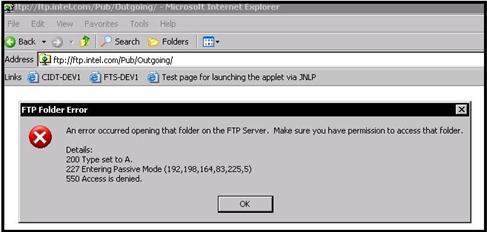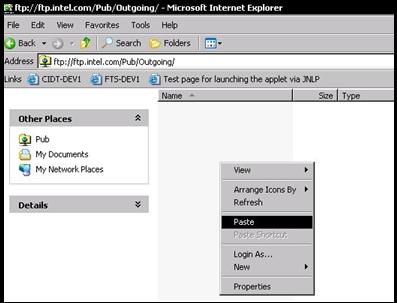Troubleshooting Overview
This page describes common issues and resolutions for
ftp.intel.com file transfer services.
Who can I contact for support?
How To Guides
Web Browser Issues
General Issues
For issues please contact
B2B.Tech.Support@intel.com
Web Browser Issues
- Within IE, goto Tools menu --> Internet
Options... and click the Advanced tab
- Scroll down and CHECK the option "Enable
folder view for FTP sites"
- Click OK button to apply the advanced
settings
- Close and re-launch Internet Explorer
This issue applied only to Anonymous file transfers. All
"incoming" and "outgoing" folders do not allow directory listing of files for
security measures. When trying to list files from these folder, an access denied
error is expected. Most FTP client GUI tools will automatically try to list
files when you traverse a file structure regardless of whether you want to see
files in the folders or not. When prompted due to the errors, just click through
the error and then try your file transfer. You may also see these Access
Denied or Directory Listing Denied errors in the FTP Client log that can be
ignored.
For example, you may see the error when browsing to the
/outgoing folder to upload a file within the Internet Explorer web browse (also
applies to /incoming folder):

If you saw the above error, click OK and then upload your file
as you normally would:

Firefox Web browser (3.6.x and possible future versions)
without 3rd party add-ons will not allow a user to upload a file. Files
can only be downloaded over FTP using this Web browser.
General Issues
Windows FTP program (sometimes referred to as FTP.exe) is not
supported due to its inability to support a feature called passive data
connections. You will need to find an FTP program that does support passive data
connections. A guide for users outside of
Intel's networks and a guide for users
connected inside of Intel may be helpful; however, there are other FTP clients
other than those mentioned in the guides that
support passive data connections are available.
Tips to gain higher performance are:
- Use FTP over Explicit TLS/SSL connections.
In some unique situations cases, this transfer method can be
faster.
- The Internet will likely have the greatest
impact on performance. In general, higher the bandwidth/speed of
Internet connection will increase performance.
- Network latency can increase transfer times
and this service is hosted in California, US; therefore, it is
likely that transferring files within the US will be faster than
transferring files outside of the US. Transferring files from
other US sites outside of California may also be slower.
- Transferring files on off-peak hours can
increase performance. In general off-peak hours are between
1:00-6:00am within a geography's timezone.
- Transferring files in parallel (or splitting
a large file and transferring each chunk in parallel) can be
faster if the network bandwidth allows this.
- To avoid possible interruptions in file
transfers and having to restart the transfer of a large file
from the beginning, you will want to confirm that your FTP
client and the FTP service you are using supports Resume
capability. Most do, but some do not. Anonymous Adhoc file
transfer (incoming/outgoing folders) do not support FTP resume
due to blind drop/get requirements. Named FTP accounts do;
however, support the ability to resume.
- For connections originating within Intel's
internal networks, avoid the use of a Proxy server. If you
are required to do this due to your network requirements, then
use Intel Proxy Server host server in your FTP Client
configuration that is closest to your current location. This
should decrease network latency.
You may be seeing a disconnect from the ftp.intel.com remote
server and still continue to see your file still transferring. This is
normal behavior. The remote server is considering your command
communication channel as idle if you are not using it while your file is
transferred and after 5 minutes, the remote server will force a disconnect.
This is not expected to stop your file transfer as a separate "data"
communication channel is being used to transfer your file and only after it
completes the transfer will that communication channel disconnect.
- Install an FTP client if none installed yet
- Configure the FTP client to connect to
ftp.intel.com using the following settings:
-
Host/Server: ftp.intel.com (port 21)
-
Mode/Connection Type: Normal FTP (unsecure), Explicit
FTP/SSL (secure), Explicit FTP/TLS (secure), or
FTPES (secure).
* Note that Implicit FTPS is not supported.
* Important note about security: To ensure that
your file transfer kept confidential always
encrypt your files before upload.
- Username: anonymous
- Password: <your email
address>
-
Choose to use Passive (PASV) Data Connections (NOTE:
this may be a command that you need to set after
connecting)
- Configure any network firewall you are
connecting through for network port 21 (control channel) and
network ports 36000-36200 (data channels) to ftp.intel.com
- Disconnect from any VPN connection to Intel's
network if you are connecting using FTP over Explicit FTP/SSL
(FTPS). This is an expected known issue with Intel's VPN
connections that has no known workaround. VPN connections
to other companies may also see this same issue where
disconnecting may also be a resolution.
Disconnect from any VPN connection to Intel's network if you
are connecting using FTP over Explicit FTP/SSL (FTPS). This is an expected
known issue with Intel's VPN connections that has no known workaround. VPN
connections to other companies may also see this same issue where disconnecting
may also be a resolution.
This known issue can be confirmed if you are able to connect
successfully using regular unsecure FTP. Some FTP client logs show a hang
after the AUTH TLS/SSL command and some FTP client logs may show an error
message similar to "GnuTLS error -73: ASN1 parser: Error in TAG.". If you
are aware that your connection is being routed through a Checkpoint firewall,
then is it possible that the firewall requires inspection of the data packets
and will drop a connection when it cannot inspect the data, such is the case
when the FTP connection starts the TLS/SSL handshake as part of the FTPS
protocol.
- This issue applied only to Anonymous file
transfers.
-
All "incoming" and "outgoing"
folders do not allow directory listing of files. When trying to
list files from these folders, you may see an access denied
error or unable to connect to site error. Most FTP client GUI
tools will automatically try to list files when you traverse a
file structure regardless of whether you want to see files in
the folders or not. Please expect these errors when using the
GUI tools when viewing, downloading, or uploading files in each
of the "incoming" and "outgoing" folders.
- This issue applied only to Anonymous file
transfers.
-
To determine whether a file upload was successful,
review the FTP log for the commands used by the GUI tool (e.g.
after "STOR myfile.txt" command you should expect to see
"Response: 226 Transfer complete")
This issue applied only to Anonymous file transfers. All
"incoming" and "outgoing" folders do not allow directory listing of files for
security measures. When trying to list files from these folder, an access denied
error is expected. Most FTP client GUI tools will automatically try to list
files when you traverse a file structure regardless of whether you want to see
files in the folders or not. When prompted due to the errors, just click through
the error and then try your file transfer. You may also see these Access
Denied or Directory Listing Denied errors in the FTP Client log that can be
ignored.
For example, you may see the error when browsing to the
/outgoing folder to upload a file within the Internet Explorer web browse (also
applies to /incoming folder):

If you saw the above error, click OK and then upload your file
as you normally would:

The "incoming" and "outgoing" folders do not allow a CD into
the folder. This is due to permissions that disallow a directory listing.
To Download or Upload a file into the "incoming" and "outgoing" folder, you must
be in the Pub folder which is the parent of the "incoming" and "outgoing"
folders. Once inside the Pub folder, specify the entire folder path
including the file name and depending on your FTP client software, you may need
to specify the local file name too.
While in the Pub folder, the following commands are examples
of what your FTP client software may support:
| |
get Incoming/myfile.dat |
| |
get Outgoing/myfile.dat |
| |
get Incoming/myfile.dat myfile.dat |
| |
get Outgoing/myfile.dat myfile.dat |
| |
put Incoming/myfile.dat myfile.dat |
| |
put Outgoing/myfile.dat myfile.dat |
It is important to note that some FTP client software tools may require the use
of the backslash or two backslashes instead of the forward slash in the above
examples
It is not possible to use wildcards when downloading files
from the /incoming or /outgoing folders when logged on using an anonymous user.
This is expected behavior. Specify the file name of each file you need to
download.
It is not possible to use the "mget" or "get -r" FTP commands
to download files from the /incoming or /outgoing folders when logged on using
an anonymous user. This is expected behavior. Specify the file name
of each file you need to download.
Be sure that your FTP client is configured for use of passive
data connections. Windows FTP client (FTP.exe) does not support passive data
connections; therefore, it is not supported.
If you are unable to find help anywhere in this guide, here
are some steps that may help
- For anonymous adhoc file transfer...
- If possible, follow the
guides for using the FileZilla FTP Client or
Internet Explorer Web browser to determine if
the problem is isolated to your FTP client.
A guide for
users outside of Intel's networks and a
guide for users
connected inside of Intel may be helpful
- If you are connected to
Intel's network, then you can only download
files from the /pub/incoming folder and upload
files into the /pub/outgoing folder
- If you are connected outside
of Intel's network, then you can only download
files from the /pub/outgoing folder and upload
files in the /pub/incoming folder
- When downloading files, you
cannot navigate into either of the /pub/incoming
or /pub/outgoing folder directly. You must be in
a parent folder and use the entire path to the
file including the file name to download it
(e.g. get /pub/outgoing/myfile.txt)
- You must be using Passive
Data Connections. Be sure this feature is
enabled. Passive Data Connections is the default
if using a Web browser. If you not sure whether
Passive Data Connections are allowed, connect to
ftp.intel.com using your FTP client and enter an
"ls" command at the root folder. If your
connection is closed automatically or becomes
unresponsive, then Passive Data Connections is
disabled; therefore, review the documentation of
your FTP Client on how to enable this feature.
- If using a Web browser to access
ftp.intel.com
- Be sure that you are using
Internet Explorer or Firefox
- Note that you cannot upload
files using Firefox
- When uploading files, you may
see an Access Denied error when browsing to the
/pub/incoming or /pub/outgoing folder. That is
expected to disallow listing of files. Click OK
to the error prompt and continue to upload the
file. You should be able to successfully upload
the file; however, you will not be able to see
the file after the transfer because file listing
is disallowed.